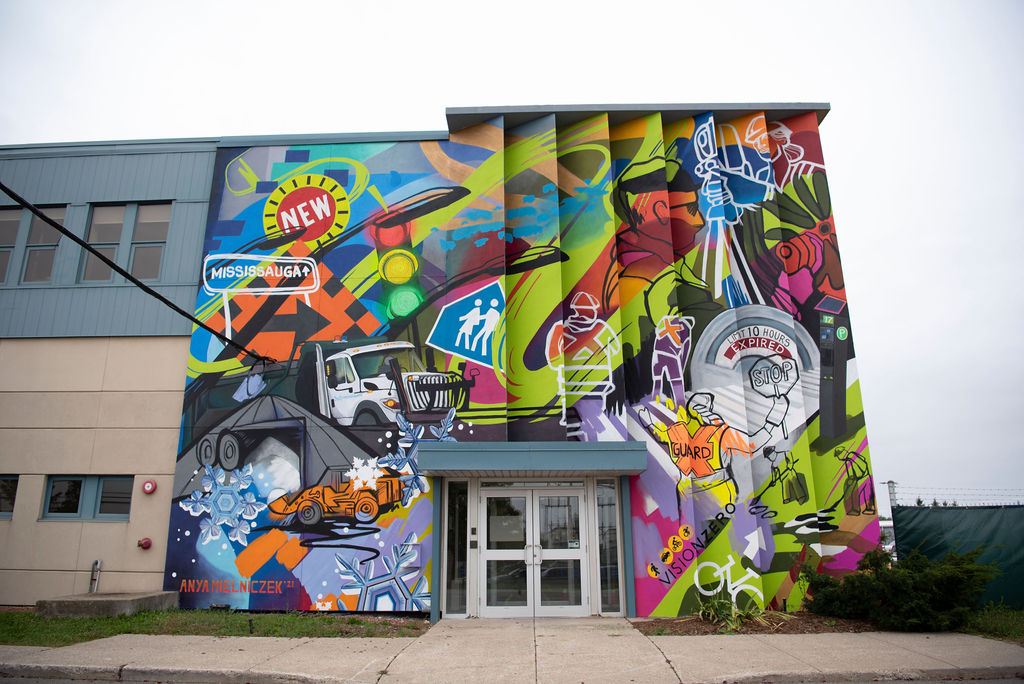Mural art

The City of Mississauga recognizes the importance of murals and street art in contributing to vibrant neighbourhoods. The City occasionally commissions large mural projects on publicly-owned spaces (buildings, fences, walls, ground, etc.) through the Public Art Program in accordance with the Corporate Policy and Procedure 05-02-07 City Art Collection.
If you are a property owner, developer, artist or community group interested in installing mural artwork on privately-owned property in Mississauga, you will need to get the appropriate permissions and may require a permit from the City.
What is a mural?
A mural is an artwork applied directly to a large surface in a public space. As a form of street art, murals are distinguished from graffiti vandalism based on consent – not artistic style. Learn more about this important distinction:
- Mural art is approved prior to its creation by a property owner or occupant, where the primary purpose is to aesthetically enhance the general surrounding as well as the surface it covers.
- Graffiti vandalism means one or more letters, symbols or marks, howsoever made, that disfigure or deface a property or object, but does not include a sign pursuant to the City’s sign by-laws or a mural, which has been authorized by the property owner.
Graffiti vandalism on private property must be removed in accordance with the City’s Property Standards By-law. You can report graffiti vandalism online.
Well-produced murals often become neighbourhood icons and can have a dramatic impact on communities and passers-by. The artwork can allow people to shape their community and create a sense of place, identity and pride. Murals in highly visible locations can often bring a community together and improve spaces for people passing by.
There is a connection between mural art, real estate, and the displacement of long-time residents – a process known as gentrification. This is an important aspect to consider when deciding whether or not to start a mural project.
Before you begin a mural project, ask yourself the following questions:
- Why are you creating a mural?
- How can the community be involved and will the mural project benefit them?
- Do you have access to the necessary skills and expertise for the whole project, including engaging the community?
- What activity happens, or will happen, in the location that the mural might affect?
- Are you confident that a mural will achieve your desired outcomes and benefits, or is a different project more appropriate?
When thoughtfully planned, mural projects can be used to address issues of gentrification, reclaim Indigenous history and rights, and highlight the importance of environmental protection.
Permission and permits
You should receive written permission from the building owner for the installation of a mural on the designated surface (wall, ground, ceiling etc.) of their property. It may also be helpful to engage the local Business Improvement Association (BIA).
Based on the location of the proposed mural art and whether certain accesses are required to complete the work, you may need to apply for a permit.
- A heritage permit may be required for murals on heritage properties or properties within a heritage conservation district.
- A road occupancy permit is required if the mural’s installation will occupy, obstruct or close a City road, sidewalk or boulevard.
- A park access permit is required if you need to access the private property through a City park or natural area to complete the mural’s installation.
Some advertisers use murals as a large-scale visual medium to attract clients or customers. Murals that attract attention to a specific subject matter for identification, information or advertising purposes and include an advertising device or notice require a sign permit and are subject to the City’s Sign By-law.
It is best to contact the City if you are unsure if your mural meets the City’s definition of advertising, especially if you wish to include sponsorship logos in your mural or accompanying signage. Please call 311 (905-615-4311 from outside City limits) or email public.info@mississauga.ca.
Artist's rights
Artists are entitled to certain personal rights that connect them to their work. These rights cannot be assigned or licensed, however the artist can contractually waive them. These rights include moral rights (an artist’s right to be associated with the work and the integrity of the work) and intellectual property rights (legal rights that pertain to ideas and creations in the artistic field).
If you are working with a professional artist, you should have a written agreement that outlines ownership, copyright and maintenance obligations. This protects artists from facing losses – creative or financial – that result from the misappropriation or corruption of their original creations. It can also protect a property owner from disagreements or legal disputes arising from misunderstandings.
Contact
If you are a local business, building owner, developer or community group looking to develop a mural project, get in touch for advice on design, fabrication, installation and how best to proceed. For more information, contact public.art@mississauga.ca.